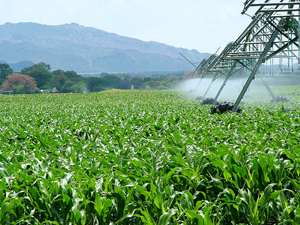Dr Henry Jordaan’s research to establish benchmarks for sustainable freshwater use in agri-food industries
 Photo: en.wikipedia.org |
Dr Henry Jordaan, Senior Lecturer in the Department of Agricultural Economics, is working on a multi-disciplinary research project for the Water Research Commission. The project assesses the water footprints of selected agri-food products that are derived from field and forage crops produced under irrigation in South Africa. These foods include animal products, such as meat and dairy, and crop products such as bread and maize meal.
“The water footprint of a food product is the total volume of freshwater that is used to produce the product, measured from the farm to the actual consumption of the food product. Thus, the water footprint is a good indicator of the impact that the consumption of a product has on our scarce freshwater resource. The agri-food sector is a major user of freshwater in South Africa with a relatively large water footprint,” says Dr Jordaan.
However, the agri-food sector also has an important role in economic development in South Africa. It generates income and employment opportunities along the value chains of the food products.
The challenge is to maximise the economic and social benefits from using freshwater in an environment where freshwater gets increasingly scarce.
Through his research, Dr Jordaan aims to establish benchmarks for sustainable freshwater use in selected agri-food industries – from an environmental, economic and social perspective. These benchmarks will inform water users on the acceptable volumes of freshwater to use to produce food products. It will also inform users of the economic and social benefits that they are being expected to generate through their actions so that their water use behaviour could be considered sustainable.